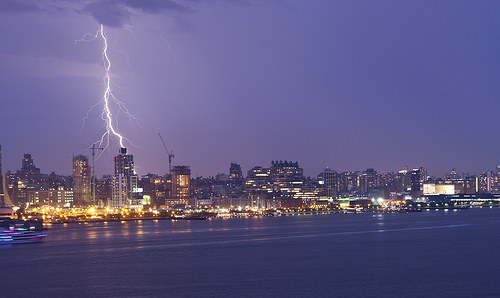Electrical energy

Electrical energy is the most convenient form of energy for most human uses. Electrical energy is easy use and move from one location to another, but it is almost impossible to store in any large quantity. It can be used for running computers and most appliances, home heating, and even transportation. Electricity is used by industry, households, and businesses—accounting for 18% of end use energy worldwide.[2]
The energy itself is held in the movement and configuration of electric charge. The flow of electric charge (usually electrons) is electric current. Charge can build up on a capacitor and store electrical energy. This energy is physically carried in the electric fields and magnetic fields associated with how charges are arranged and moving, but can easily be turned into most energy services.
Electrical conduction is the physical phenomenon that allows electricity to be transported easily. Wires, materials made out of conductors (usually metals), are capable of transporting this energy hundreds of kilometers. This system of transporting electrical energy is called the electrical grid.
Electrical energy is not a primary energy source, but rather an energy currency (read more in the article electricity as an energy currency). Primary energy (like wind or natural gas) goes into an electric generator to make electricity for easy use and transport. The energy that is transported and used by so much of the modern high energy society must come, fundamentally, from some primary fuel or primary flow.
Electrical energy is very convenient, and as a result more and more of the energy used by a high energy society is in the form of electricity, see figure 1. The rate of electrical energy use is growing faster than the rate of electricity use, see figure 2.
Figure 1. The above graph shows how electricity use is growing as a percentage of the total final energy use in the world.[2] This shows that the flexibility of electricity creates a strong incentive to have as great a fraction of energy produced in that form as is possible.
Figure 2. The above graph shows how electricity use is growing faster than the total final energy use in the world.[2] This shows that the flexibility of electricity creates a strong incentive to have as great a fraction of energy produced in that form as possible.
Data visualization
Explore the data in the simulation below to find out how the electrical energy varies by country and by sectors within that country. Click on a sector on the right side of the visualization to explore its end use paths in more detail, and click "see all categories" to return to the original screen.
For Further Reading
For further information please see the related pages below:
- Direct current
- Energy for electricity by country
- Electrical grid
- Electric generator
- Or explore a random page!
References
- ↑ Quintano, Anthony. (2014, Aug. 20). Lightning over New York City July 2013 [Online]. Available: https://www.flickr.com/photos/quintanomedia/9334838960/
- ↑ 2.0 2.1 2.2 Data taken from oecd.org (the Organization for Economic Cooperation and Development) accessed October 30th, 2014

